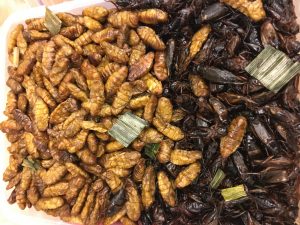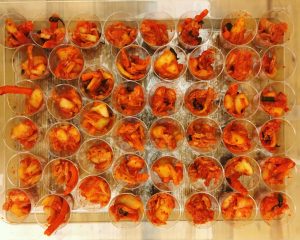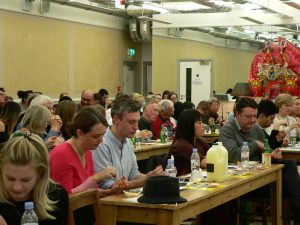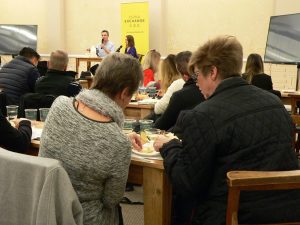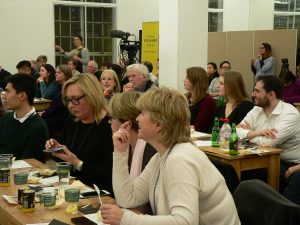We spent an evening exploring unfamiliar food with Chef Saiphin Moore, kimchi expert James Read, food writer Fuchsia Dunlop and dairy expert Srdja Mastilovic. Each took a bitesize turn in describing their experience with unfamiliar cuisines.
Saphin Moore began the night by sharing tasty tips on various ways to cook insects – whether steamed, fried or curried. She went on to explain how, growing up in Thailand, insects such as silk worms, caterpillars and crickets were the only meat they ate – other source of protein, such as chicken, beef and pork were an expensive indulgence. Eating insects is also a great form of pest control. Saphin shared how catching and turning crickets into meals became resourceful and convenient, prevented their corn crops from infestation and ultimately, ensured there was food on the table.
As the audience tucked into their insects and ant egg soup, Saphin described how including bugs in our everyday diet could provide a solution to the global food crisis and reduce the impact of meat farming on the environment. Saphin is proud to bring insects into the UK and determined to spread this unfamiliar diet by serving insect dishes at her restaurants, Rosa’s Thai Café and Lao Café in London.
James Read was up next, getting us into a pickle with the science of fermentation and the role it plays in the distinctive flavours in many cuisines, particularly in Korean and Sichuan dishes. Kimchi is a staple dish in Korean cuisine and according to James, it can consist of various ingredients depending to what region of Korea you are in. For him, the best kimchi is made out of napa cabbage. He explained that almost any ingredient can be added during fermentation such as carrots, cod gills, oyster, aubergine, and the most important ingredient, chilli powder (also known as gochugaus).
As our audience dug into this Korean delicacy, James invited the audience to play fermentation bingo, showing everyday foods that went through a process of fermentation – like bread, soy sauce, chocolate, coffee and more. He went on to talk about the anaerobic metabolism process of raw vegetables that gives the sour taste that tingles our taste buds.
For our third course, Fuchsia Dunlop addressed the symbolism behind eating a duck’s tongue and other unusual flesh in Chinese cuisine. She explained that eating unusual parts of an animal did not come about from desperation and economic deprivation but for cultural reasons. A plate full of duck tongues, for example, symbolises an individuals’ power and social status as they have something that most people are not able to get access to.
Mouth-watering duck tongues were served to our audience, as we discovered that nose-to-tail eating is commonplace in China, as it is believed that no part should be taken for granted. Sharing her life experiences in China, Fuchsia said that duck tongues, chicken feet and fish heads are highly prized in Chinese gastronomy.
Srdja Mastilovic was our final guest for the night, delighting us with cheesy facts and milky fun! He revealed that in the past making cheese was to provide something to eat as the natural production of milk is only seasonal. He passed around some unpasteurised milk – explaining that this ‘raw’ milk is what is needed to make cheese. Audience members then got to sample a Neal’s Yard blue cheese.
The evening closed with a complementary baijiu (Chinese wine) sampling ahead of China Exchange’s upcoming event Hello Baijiu – a tasting and cocktail masterclass. Book now for 20th February 2017.

